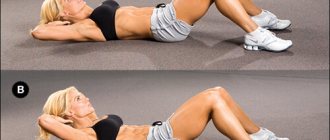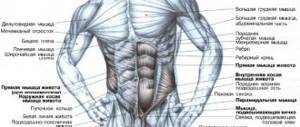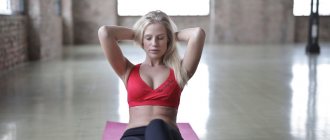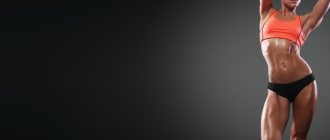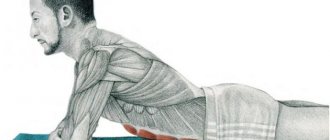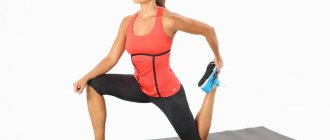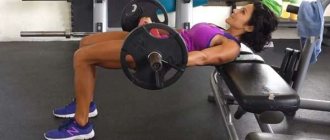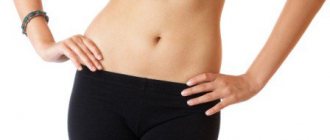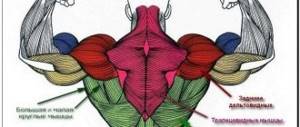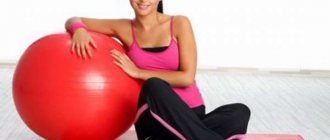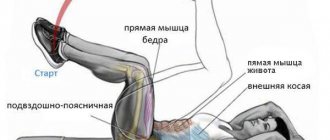Content
- 1 Home exercises for the abs
- 2 Why “six hellish dice”?
- 3 Body sit-ups and other modern madness
- 4 Old School Techniques: Leg Raises and Torso Raises
- 5 Leg Raise Series
- 6 Notes on ab training
- 7 Options 7.1 Hull lifts
- 7.2 Yanda ascents
- 7.3 Bent-over sit-ups
- 7.4 Roman chair raises
- 7.5 Twisting lifts
- 7.6 Russian crunches
- 7.7 L-post
- 7.8 Medicine ball training
- 7.9 Side leg raises
- 7.10 Twisting leg raises
Complication
If classic body lifts seem too boring to you, then you can supplement them with turns. Just keep in mind that with such exercises the emphasis is on the oblique muscles. Girls should not get too carried away with this, as the oblique muscles visually widen the waist.
The starting position is the same as for normal lifts. Next, begin to raise your torso, and at the moment when your shoulder blades come off the floor, turn your torso to the side and reach the maximum point, then take the starting position. Perform body lifts with turns alternately to the right and left.
Home exercises for the press[edit | edit code]
In modern fitness, no part of the body receives as much attention as the rectus abdominis muscle, popularly known as the “six pack.” Every self-respecting fitness publication considers it its duty to devote an article (or even several) to the “six pack.” Turn on the TV and on any channel you will certainly see an advertisement for a state-of-the-art machine that will give you six packs in just four minutes a day. Well, or something like that.
I want to say right away that such nonsense causes me nothing but disgust. I have absolutely no intention of dieting and training for cute muscles. By far, the “six pack” is the best-selling product in the fitness industry. Millions of dollars are earned from the naive human desire to certainly have such a press by selling all kinds of equipment, books, DVD trainings, etc. I despise them all. I despise them because they are the essence of everything that is wrong with modern physical culture. It's image over substance, a belief in a corrupted vision of what a man's body should be - graceful and thin, like an underfed teenager, rather than strong and muscular, like a man's. This is wasted time and energy on stupid, useless, stupid exercises: not only will such courses lead to nothing, but they will not improve your health either!
Everything is done solely for the sake of stroking one’s own vanity.
Why “six hellish dice”? [edit | edit code]
Small bulging muscles on a tanned stomach and a thin waist - this is the modern idea of a six-pack. An underage Brazilian call boy may well have such a belly, but not a real athlete. If you like this, there's nothing you can do. But definitely not for me.
Abs are much more than you might imagine. Much, much more. These are not just smooth bulges on a skinny body, but damn powerful rectangles obtained as a result of hellish training. So here's my understanding of abs.
Six hellish dice consist of the following “components”:
- The incredibly powerful abdominal muscles are not just the central part of the torso, but all the abdominal muscles: obliques, transverse, lumbar, intercostal and serratus. The stronger the central part of the body, the stronger the entire body.
- Extremely flexible yet powerful abs and thighs not only support the spine, but are also key to safely performing intense and fast movements such as jumping and kicking.
- The abdominal wall is so dense and well-trained that it can not only protect against attacks from ill-wishers, but also cause considerable damage to them themselves!
- Lean abdominal muscles that support internal organs involved in breathing and digestion. Strengthening the press makes them healthier and generally has a positive effect on human health.
- Powerful and well-trained abdominal muscles look like bricks in a wall, and not like the charming abs of a fitness model.
These are the qualities that the prisoners I know are looking for in their training. If you want to temporarily get those small, boxy abs like those that boys or swimmers boast, don't read this chapter—go back to the glossy fitness magazines or advertisements. But if you like the hard abs of a real man, all the information presented below is intended especially for you.
Body lifts and other modern madness[edit | edit code]
The first thing you need to do to get powerful abs is to forget about all the exercises that you were careless to learn in modern training. It may surprise you to know that all these “unsurpassed” techniques that trainers shout about from the pages of glossy magazines are actually not intended for the abdominal muscles at all.
I'm talking about exercises like crunches, reverse crunches, crunches, bent over crunches, etc.
In the pre-steroid era, all strong men trained to get a six-pack from hell. They wanted to have tight, strong, masculine bellies. And the strongmen of the old school had not only more developed abs than any modern bodybuilder, but in general its functionality was an order of magnitude higher. Their ideal was the Greek athletes of antiquity, who performed a lot of powerful twisting movements - such as the javelin throw - to develop the oblique abdominal muscles. If you look at the sculptures of that time, you can easily notice that the waists of the statues are not thin at all, but steep, powerful and muscular.
The sit-up became incredibly popular with the advent of the steroid era. When steroids are used, not only the muscles of the arms, back, legs and abdomen increase in size, the abdominal wall and internal organs also increase in size. Athletes who do not use steroids will never be able to achieve the same visual muscle volume that is only achievable with chemicals. In fact, those who used steroids experienced quite ugly results, especially in the abdominal area, which was called the steroid belly (“roidgut”). It's clear that none of these guys were interested in stronger and healthier abs per se, so they neglected effective ab exercises and came up with something of their own that seemed to put stress on the abs. This is how crunches were born - pathetic isolation exercises designed to massage the abdominal wall and slightly define the abdominal muscles in preparation for posing during competitions. Crunches are absolutely incapable of adding real strength and muscle. But modern bodybuilders don't care - they just desperately want to reduce the size of their artificially inflated bellies.
Unfortunately, the useless training methods of modern bodybuilders, taken at face value, have become very popular in gyms around the world, making it difficult to find effective and safe techniques for working on the abs. It's no surprise that a true six-pack is a rarity these days.
Another modern myth is the need to perform a variety of exercises in order to properly train your stomach. Many argue that sit-ups work the upper abs, while leg raises, on the contrary, work the lower abs. Any person with the slightest understanding of anatomy will tell you that this is complete nonsense. The abdominal muscles are attached on one side to the sternum, and on the other to the pelvic bones. They all contract evenly along their entire length, no matter how we move. If, for example, you fasten a rubber band at both ends and, by pulling one end, try to stretch the other more, nothing will work, because all the muscles stretch and contract evenly along the entire length.
Modern training ideology is obsessed with the “six pack.” It is much more important and smarter for the development of athletic capabilities and true strength to think not about the notorious cubes, but about the abdominal muscles and the central part of the body as a single whole. This part of the body consists not only of the rectus abdominis muscle, but also of a dozen other equally important muscles. After all, exercises for the middle part of the body involve the muscles of both the upper and lower parts of the body, they work as auxiliary ones, allowing the muscular system to develop harmoniously. This is why machines and isolation exercises such as crunches do not produce the desired results. Only movements that involve the whole body - throws, pull-ups, punches - allow muscles to grow and develop in a natural and balanced way.
Old School Techniques: Leg Raises and Torso Raises[edit | edit code]
The main task of the muscles of the midsection is to maintain and stabilize the body. If these muscles are weak, then the body is ineffective. And if you need to exert force, these muscles literally burn. So if you want to take your abdominal muscle development to the next level, you need to target them with a single movement. You will need to truly master this movement so that your stomach has truly unprecedented strength - this will be your “six pack from hell”!
Body sit-ups and leg raises are two exercises that in the good old days (before the 1970s) were considered sufficient to work the midsection. These two different lifts are performed in opposite directions - body raises lift the core, and leg raises lift the legs (up to hip level) by strongly squeezing the abdominal muscles. But remember, you don't have to do both exercises during the same workout - as I said earlier, the abs work the same in both lifts. But which exercise is more effective?
Both are equally effective, but leg raises were more popular in prison for the following reasons:
- Leg raises require less equipment than body raises. This is important, especially in prison. To lift your body, you will need an adjustable bench, or a Roman chair, or a support object, or better yet, all three. To raise your legs, you only need a horizontal bar or crossbar or a tree branch or something similar. If you try, you can always find something to hang on.
- Leg raises are more practical than torso raises. Torso raises are good at challenging the nervous system to lift the torso forward at the hips, and leg raises train the hips to lift the legs. The second action is much more natural and useful in sports: jumping, wrestling and kicking.
- Leg raises work more muscles than torso raises. Obviously, hanging leg raises require more muscles to work than body raises. The hang, as you already know, works the grip, shoulders, back muscles and forces the serratus muscles, which support the rib cage, and serve as an important link between the ribs and the abdominal muscles, to work. To hold the legs in a horizontal position, the deep muscles of the quadriceps of the legs work.
My ab training system is based on leg raises, precisely for the reasons stated above. Leg raises are the most effective abdominal exercise ever known to man - necessary and sufficient for strong and healthy abdominal muscles.
Leg raise series[edit | edit code]
Most people who train are very familiar with hanging leg raises. The technique of the exercise is simple - hanging on the bar, you need to slowly raise your straight legs, keeping your knees together until they become parallel to the floor, stop for a second and slowly lower your legs down. It's simple.
But precisely because of its apparent simplicity, the technique is difficult to perform, because pure execution requires steel abdominal muscles, powerful, well-developed thigh muscles, lower back muscles, spinal muscles and sufficient mobility of the hip joint.
Leg raises are performed at a slow pace with perfectly straight legs—a technique that may not be feasible for many, even professional wrestlers and weightlifters. But don't worry about this - no one is asking you to do straight leg raises at the very beginning of the program. The Big Six system is based on gradually increasing the complexity of exercises, so you will first learn simple exercises and gradually move on to more complex ones. At the first level, knee tightening will prepare the abdominal muscles for stress and strengthen the joints. The following four types of exercises are performed on the floor - each one is a little more difficult than the previous one. At the following levels, the exercises are performed hanging. In this position, the abdominal muscles receive a tremendous load, and as they strengthen, we will move on to the most difficult exercise - hanging straight leg raises. The result of this approach will please you - your abdominal muscles will be much stronger than those of the vast majority of athletes.
And all this without crunches, special exercise machines, fitballs, electrodes and other modern nonsense.
Incline sit-ups
By doing incline sit-ups, you train your upper abdominals. After you take the starting position, begin to lift your torso, but when returning back, do not lie down, maintain tension in your muscles. This will not only significantly improve efficiency, but also eliminate the risk of injury to the lumbar region. Raise your torso until a right angle is formed between it and your legs. Hold this position for a second and return back. Try to use your legs as little as possible.
Notes on ab training[edit | edit code]
Some abdominal exercises are very different from each other, so in order not to overwhelm you with details, I want to briefly outline the basic principles - I will outline a number of general recommendations that will help you understand the technique of performing leg raises and apply them in practice.
- Breathing contracts the abdominal muscles and intercostal muscles. Remember how your stomach hurts if you laugh too hard and for too long? Inhale as you relax during the movement and exhale completely at the highest point to increase the effect. You can also take an extra breath in the pause between movements.
- The transverse abdominal muscles form a thick abdominal wall, a kind of corset that holds the internal organs. If the muscles of the abdominal wall are weak, then under the influence of intra-abdominal pressure a hernia or hernial sac can form, into which internal organs can fall out. Therefore, it is necessary to train the transverse muscles, keeping the stomach tucked. Moreover, throughout the day, tighten your stomach, do not protrude it, develop good posture.
- Some people claim that leg lifts can cause back pain. If you perform the exercise slowly, there will be no pain. Sometimes back pain can be caused by a muscle imbalance—if your abdominal muscles are stronger than your back muscles. Squats and bridges will help develop the muscles of the spine. Incorporate back strengthening exercises into your program along with leg raises to avoid uneven development of the back and abdominal muscles.
- Do not exercise on a full stomach - start exercising no earlier than two hours after eating. Otherwise, not only the execution technique will suffer, but also the stomach.
- If straight leg raises cause difficulty, then mobility of the hip joints may be difficult. Try stretching exercises.
- It is believed that frequent lifting of the torso makes the abdominal muscles prominent. Muscle definition is achieved by reducing the fat layer. You can't get rid of fat in just one place. Generally, the body sheds fat evenly, so don't waste time doing high-intensity reps doing abs in hopes of losing fat in just that area.
- If you want to get defined abdominal muscles, work carefully on the exercises throughout the program and, when the muscles become strong and strong, go on a diet to get rid of excess fat.
- Modern abdominal muscle training programs consist of isolation exercises designed for frequent repetition, and include all kinds of crunches to work the muscles, as they say, “from all sides.” These mini-exercises do not give any results. Good training and muscle building are based on the use of the entire human muscular system, so instead of small tricks, it is better to work on the Big Six program.
Many bodybuilders believe that high-intensity bar crunches will help get rid of excess belly fat. It is a myth. If, for example, you run four marathon distances a week, your muscles will be overloaded and exhausted. Of course, excessive exercise will not lead to muscle atrophy, but it will contribute to the loss of muscle fibers. Moreover, frequent twisting does not have the best effect on the spine.
- Leg raises are easier to perform by swinging your body and using momentum. But this is definitely bad practice. To get strong and healthy abs, follow my instructions exactly.
So, the theory is over. Let's start training. Abs training program for home
Ab exercises
The abdominal muscles do not require too much attention to themselves. It will be enough if you set aside 15-20 minutes to do the exercises. In addition, you can create a set of abdominal exercises that are suitable for you and perform them both before and after the entire workout. If you have just started working out your abs, then it is best to choose some simple exercises and do a small number of repetitions every other day. Over time, you need to complicate the exercises and increase the number of repetitions. The main thing in this matter is to feel your body and do each repetition diligently and according to the correct technique. The most basic exercise is lifting the torso. It is considered the main and one of the most effective.
Options[edit | edit code]
Almost every fitness publication publishes "the latest and most effective ab programs." All of them, as a rule, are based on crunches and their variations - the most useless exercises that physical culture has ever known. There are many different crunches: reverse crunches, twisting crunches, bent over crunches, side crunches, fitness ball crunches - similar to machine crunches. These are all essentially isolating and rather miserable exercises. They are completely unable to transform the belly into something functional and athletic. Therefore, for those who value their time, I recommend avoiding any crunches and exercise machines. Other exercises will bring much more benefit - time-tested, but forgotten by modern sports fans.
Body lifts[edit | edit code]
A classic but simple exercise that works your abs and thighs well. Lie on the floor, bend your knees, tuck your feet under a heavy object for counterweight, and lift your body from your hips. Some people claim that sit-ups are bad for your spine, but this is complete nonsense if you have a good bend in your knees. Do not put your hands behind your head, otherwise you may strain your neck ligaments. Instead, bring your fists to your temples and rise until your elbows touch your knees. I've read tons of articles written by vaunted experts who claim that lifting has no effect on your abs. Apparently, these scribblers have never tried to perform these exercises themselves. A couple of hundred lifts - and the next day you know exactly where the abdominal and thigh muscles are. The only drawback is that the body quickly adapts to the load and you need to constantly lift weights. If you don't want to lift weights, try more advanced sit-ups like bent-over, Roman chair, or Janda sit-ups.
Janda's ascents[edit | edit code]
Janda lifts are named after the Czech scientist who invented them. They are very similar to classic sit-ups, with the only difference being that the feet are pressed into the floor and the buttocks and thighs are strongly tensed during the lift. According to the theory of mutual inhibition, when the muscles of the buttocks and the back of the thigh work, there is no load on the hip flexor muscle, since they are anatomically opposite. Proponents of this theory argue that when the hip joint does not work, but the gluteal and thigh muscles work, then the entire load is shifted to the abdominal area. I highly doubt it. For starters, isn't it true that when one muscle contracts, the opposing muscles don't work (Lombard's paradox is a good example, see p. 83)? Besides, why would you want your hips to stop working? The abdominal and pelvic muscles developed as one unit, so if you train some muscles and not others, you're setting yourself up for trouble. However, given all of the above, Janda raises are a useful exercise in the training arsenal due to the isometric load on the abdominal muscles, during which they contract intensely. Start doing Janda raises only after you have crossed the bar of 50 classic sit-ups.
Bent-over sit-ups[edit | edit code]
For this exercise you will need an incline bench. Secure your legs in the upper position and perform body lifts. Gradually raise the top edge of the bench a few degrees higher as the exercise begins to become easier for you. Perform raises until the bench is almost vertical.
Roman chair raises[edit | edit code]
Roman chair ab exercises are more challenging than regular bent-over exercises. Hook your feet onto something that also supports your hips and lean back. Performing lifts in this position is complicated by the lack of support for the back and pelvis and a wider range of motion than in inclined lifts. Therefore, the entire load shifts to the abdominal muscles. This exercise was popular during the golden era of bodybuilding in the 1930s and 1940s. Famous athletes of that time, Zabo Kozevski and Leo Robert, had incredibly powerful and strong abs, unlike modern bodybuilders. The exercise is usually performed on special equipment, but in prison, for example, an ordinary chair was used, and someone else held the legs. I've seen guys jump up and grab a basketball hoop with their feet as a Roman chair. I would not recommend doing such a trick to those who are not entirely confident in their abilities, but this example shows that when there is a desire, opportunities are found. The whole world around you can become a gym if you are determined and inventive enough.
Twisting body lifts[edit | edit code]
These are classic lifts, with the only difference that when moving up you need to touch the opposite knee with your elbow. And, accordingly, in the next rise it’s the other way around. Many bodybuilders (and boxers, who should know better) perform the exercise in hopes of strengthening their obliques. Unfortunately, not much muscle effort is required to perform the lift and the crunch itself, so the obliques do not receive the necessary load. Soviet trainers realized this decades ago and came up with a more effective exercise for the obliques called Russian crunches.
Russian crunches[edit | edit code]
Sit on a Roman chair or take any position that keeps your torso horizontal without support. Take a weight: in gyms this is usually 20 kg, but in prison we took a heavy book or water bottles - one in each hand. Then slowly tilt your body to the side. Keep the weight on straight arms. Twist from left to right. The arms (and therefore the stomach) should move in a small amplitude, say, from ten to two o'clock on the dial. Your muscles will tell you how to perform the exercise correctly: as soon as you feel the unbearable heat, you have mastered the technique. There are no advanced variations to this exercise, but it is a fun variation that can be incorporated into your workouts from time to time.
L-shaped post[edit | edit code]
Sit on the floor, straighten your legs, hold your arms straight, rest your palms on the floor. Now, pressing hard with your hands on the floor, lift your legs and pelvis off the floor. Maintain a right angle between your legs and body. Not only do you need strong abs and thighs to keep your legs from sinking, but you also need strong back and arm muscles to
lift the weight off the floor. The exercise is similar to the final position of hanging leg raises, but it is not as effective due to the lack of movement. Moreover, while hanging, the intercostal and serratus muscles are worked out, which is what this exercise lacks. But for variety it is quite suitable.
Medicine ball training[edit | edit code]
The medicine ball was an integral part of many athletes' training many years ago. But this practice has long been forgotten. Throwing and catching a heavy medicine ball on the fly is a great workout for all the muscles in your midsection, especially the transverse muscles and diaphragm. This type of exercise makes you contract quickly.
deep muscles that protect internal organs. You don’t even have to buy a medicine ball, but use a regular basketball one, but just strain your muscles more during training. Moreover, you don’t need a partner to work with the ball; a good wall in a safe place is a completely worthy replacement.
Side leg raises[edit | edit code]
Lie on the floor on your side. Keeping your legs straight, lift your top leg as high as possible. The ideal is a right angle, but this will be difficult at first since the sides of the thighs are usually weak unless you skate or do martial arts. Once you can do 50 reps, move on to doing standing raises (one leg at a time) - this will be significantly harder. A more complicated technique for this exercise is with weights. You need to take a weight plate or dumbbell in your hand and place it on your head. But I do not recommend taking weights - in this case, the lower spine experiences a dangerous load. Modern fitness literature contains many tips and tricks for performing lateral raises and crunches, which are supposedly beneficial for the lateral muscles. In fact, leg raises work all the muscles, including the obliques, and create strong, healthy thighs. If you train diligently with my program, no additional side exercises are needed. But if for some reason you need to work this area, then it is better to train twisting leg raises.
Twisting leg raises[edit | edit code]
This is the most specialized exercise for the sides of the body, but you need to be strong enough to even try it. Start with lateral leg raises and work through a series of regular leg raises. While hanging on the bar, straighten your legs as much as possible. In the top position, lift one hip up and rotate your pelvis as high as possible. Remember to twist evenly in both directions. One set is thousands of times more effective than crunches. The powerful obliques will stand out like steel bars on your abs, and the strength and athleticism you'll achieve will be admirable. Because it is strong, powerful and painful. You can poke a stick of dynamite with a pencil for a long time, but if you hit it with a hammer, it will definitely explode. Muscle cells work in much the same way. Just forcing them to contract won't make them get bigger or stronger, which is why electrical stimulation of the abdominal muscles doesn't work. But if you start using the right, powerful and sometimes even unbearably difficult exercises, the result will not be long in coming. So finally take a hammer. Pull yourself up and go ahead - do leg raises.
Raising the torso
This exercise can affect your body differently depending on the execution, number of repetitions, and weights used. Full lifts engage all of your abdominal muscles. Full body lifts have a large amplitude, which increases muscle work.
Technique:
- Sit on a mat, preferably a soft surface for ease of execution, bend your legs at an angle of approximately 90 degrees. This position helps transfer the load to the abdominal muscles and removes it from the spine.
- Secure your feet by placing them under any surface, such as the bottom bar of a wall bars. You can also use two dumbbells for this purpose, or simply ask another person to hold you. If you perform the exercise at home, a sofa is ideal.
- The starting position has been accepted, it’s time to start the exercise. The head and shoulders should rise first, followed by the rest of the body. Raising a straight body is incorrect. This exercise should resemble a crunch. After your torso has reached a vertical position, return to the starting position without placing your head on the floor. It is best to keep your hands behind your neck. Exhale while lifting.
- It is important to ensure that it is the abdominal muscles that do the work. Don't try to help yourself with other parts of your body. This will only reduce efficiency. If the execution is too difficult for you, you can hold your hands in front of your chest. And if you want to complicate the exercise, you can take weights, for example, a pancake.
Also very popular are partial lifts of the body from a lying position. They can be performed by people of any level of physical fitness. Such lifts of the body differ from full ones in that they work the rectus abdominis muscles. The technique for performing this exercise is very similar to full body raises. The starting position is exactly the same, hold your hands the same way. You just need to lift only the upper part, barely lifting the shoulder blades, and then return to the starting position.
